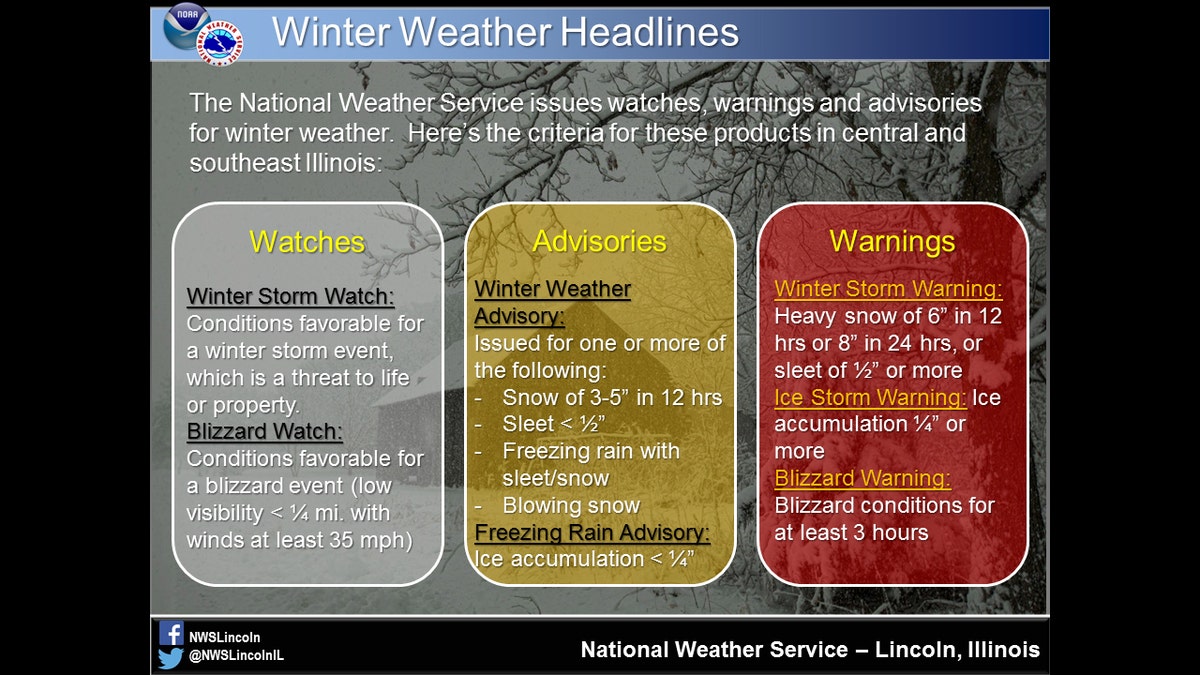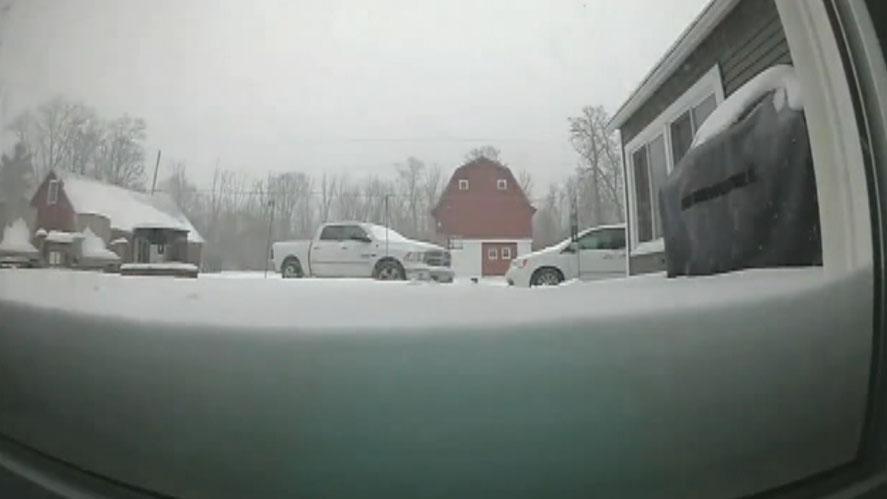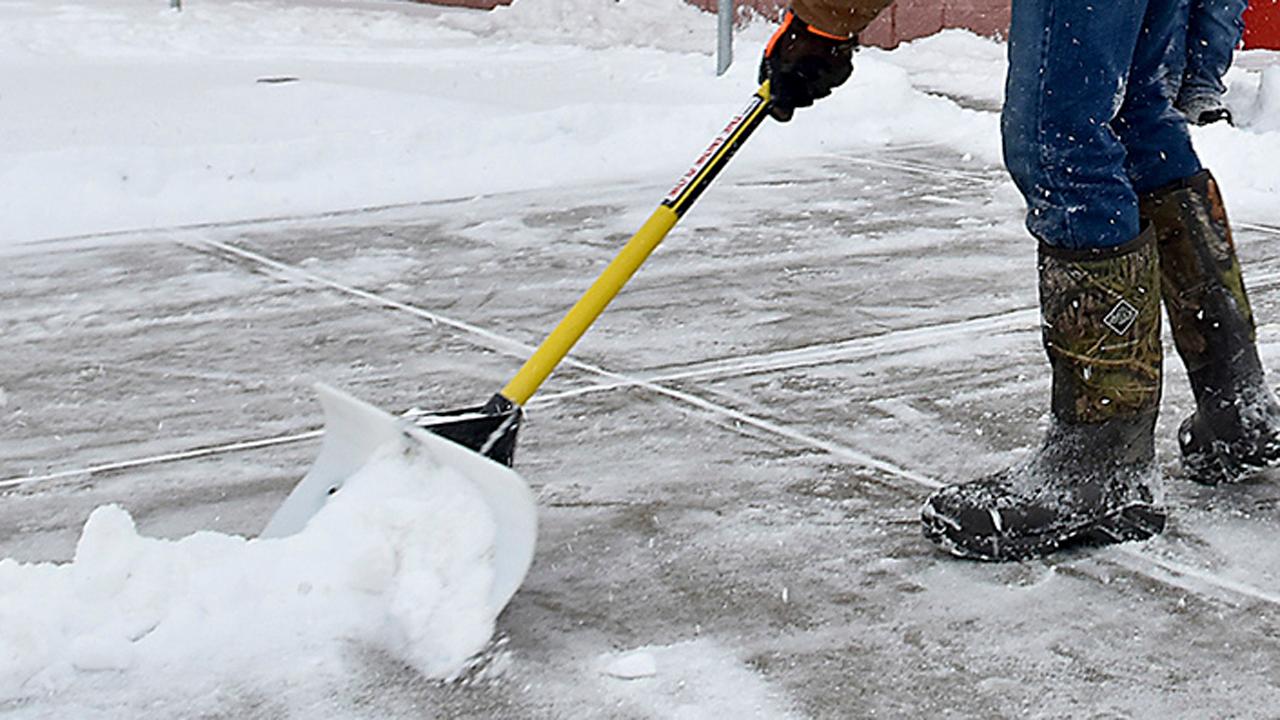Winter storm warning vs. winter weather advisory: Here's the difference
Here is what you need to know about the difference between winter storm warning and winter weather advisory.
As the temperature drops and precipitation looms in the forecast, phrases such as "winter storm warning" and "winter weather advisory" are used regularly.
Winter weather that impacts public safety and transportation -- such as snow, sleet, ice -- typically occurs between Oct. 14 and April 14, the National Weather Service says, and meteorologists' alerts before storms inform the public of any danger.
POLAR VORTEX, BOMB CYCLONE, SLEET: HERE'S WHAT THOSE WINTER WEATHER TERMS MEAN
So, what's the difference between a warning, an advisory and a watch?
Winter storm warning
Weather that includes snow, sleet, ice or freezing rain along with specific criteria, prompts a winter storm warning from forecasters.

A graphic from the National Weather Service in Lincoln, Ill., showing the difference between a winter storm warning and winter weather advisory. (NWS)
According to the NWS, warnings are issued when hazardous winter weather is occurring, imminent, or highly likely over part or all of the forecast area.
"Winter storm warnings are usually issued in the period of 12 to 24 hours before the storm starts, and occasionally beyond that as much as 36 hours before the storm moves into the region," according to the NWS. The criteria for what counts as a warning can differ among regions.
In the forecast area that includes New York City, for example, it means at least 6 inches of snow are expected in a 12-hour period, or 8 inches of snow is expected in a 24-hour period.
For ice, accumulations must meet or exceed a half-inch of ice, according to the NWS forecast office in Upton, N.Y.
"A warning may still be warranted if the event is expected to exceed advisory criteria, but fall just short of warning criteria and will significantly impact mass transit and/or utilities," the agency states.
10 DEADLIEST US TORNADOES ON RECORD
Winter storm warnings also may be issued if there is heavy snow combined with strong winds between 25 to 34 mph that will cause blowing and drifting of snow.
Winter weather advisory
If winter weather approaches and does not exceed the criteria to warrant a warning, then forecasters issue a winter weather advisory.
"Winter weather advisories are issued for events that have a high likelihood of occurrence, are imminent, or are already occurring," according to the NWS. "However, advisories are issued for wintry weather that creates a considerable inconvenience while not posing an immediate or direct threat to life or property, nor a widespread disruption of commerce."
Winter weather advisories usually are issued 12 to 24 hours before the storm starts, and occasionally beyond that as much as 36 hours before a storm moves into the forecast area.
According to the NWS forecast office in Central Illinois, a winter weather advisory is issued for an all-snow event where 3 to 5 inches of snow is forecast in a 12-hour period. An advisory also may be issued for expected snow, sleet, or a trace of ice accumulation.
"An advisory may still be warranted if lesser accumulations will significantly impact mass transit and/or utilities," according to the NWS office.
CLICK HERE FOR MORE WEATHER COVERAGE FROM FOXNEWS.COM
Winter storm watch
Forecasters at the NWS will issue a "winter storm watch" when significant and hazardous winter weather is expected.
"It does not mean that significant and hazardous winter weather will occur...it only means it is possible," according to the weather agency's Baltimore/Washington forecast office
Watches occur when conditions are favorable for hazardous winter weather conditions to develop over part of the forecast area in the 24 to 26-hour period from the start of the storm.




